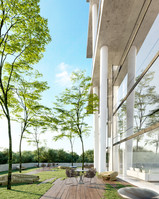What is a 3D rendering and how much does it cost?
- Arie Levy
- May 26, 2022
- 3 min read
This question is often answered by partial explanations without taking into consideration what a rendering truly is.
A rendering is a three-dimensional representation of an unbuilt space which contains all the project’s information within an image. By project’s information we mean: the space itself with accurate dimensions, materials and finishes, appliances, furniture, lighting, design details and more.
The story of renderings goes back to the first animated movies, where with the creation and use of specialized software they were able to “mimic” reality, and more importantly, mimic a camera to take a snapshot of that reality.
The virtual reality industry has come so far that today it becomes hard to distinguish a render from reality.
What does this mean in practical terms? How does this apply to your architecture or design project?
This means that you are able to visualize how the space will look before touching a single wall in your house. How professional your rendering provider is will determine how close your image will get to the future reality, and as in any service in the world you’ll find different levels of professionalism and results.
Who does this kind of work?
This is a key question. Many architectural or design firms will offer this service as something included in their fees. Usually the quality of their images is below average because it takes a very deep understanding of the softwares and high end computing equipment, so what you’ll often get is a 3D representation that is far away from reality, from the materials and finishing to the lighting, everything seeming a bit off. On the other hand you can hire an independent rendering artist with years of experience, amazing creativity and image quality, however he’ll need every bit of information about the project in order to get the right result, and he’ll generally be more focused on the beauty of the image than the correct representation of the selected elements. Getting both worlds combined (the technical and the artistic sides) can be a true headache for the simple reason that they have different purposes and they aren’t willing to spend time connecting with each other to ensure that no information is missing. It is like asking a tattoo artist to call your dermatologist to make sure that your tattoo won’t mess with your other treatments, it is possible, but you’ll have to make the phone calls and be responsible for the whole thing (and maybe have your tattoo dream crushed by your dermatologist).
Finding this odd separation in our industry and the harmful consequences that it had for the projects and the clients, we specialized in both sectors in an individual way, and we succeeded to the point that other architectural firms started to ask for and use our rendering services, and from working with them, and having a close experience with their own internal problems, we evolved our system to the point where there’s no separation. And that’s what we offer at Levy Design Group: a signature process that is driven by technology. There’s no other known firm (at least not known by us) with both sides as polished and evolved as ours.
As a last point, let’s talk about the purpose of having a rendering done.
A pretty image to show to your friends and family? Sure. But how about a visual contract?
Having a professional rendering done will actually save you money and time. This is a communication tool that you use to show and align everyone involved in the project, from the general contractor, sub-contractors and builders, to designers and decorators and pretty much anyone relevant to the project. You just need to tell them: look, this is the goal for our project, can you help me getting there? By the way, it also helps aligning design conflicts between spouses, we’ve seen it a hundred times.
Oh, almost forgot! The cost of a rendering is generally somewhere between $250 to $2000 USD per image.
We hope you had a good read, and thank you for staying interested, we’ll be happy to assist you or give you a quote if you need help.
Here are some of our favorite images created for ourselves and for other architectural firms.



















